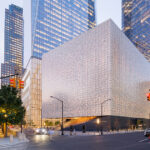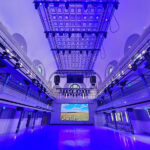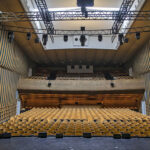The First Baptist Church of Marco Island, Florida, had a problem: They’d outgrown both the size and technology of their 30-year-old facility. But on a small, conservative island populated mainly by senior adults, how could the church keep to its core while also reaching out to a younger, hipper generation — at home and around the world?
“We live on an island with a lot of older people on it,” says Senior Pastor Tim Neptune. “We couldn’t ostracize them by going with this extremely new contemporary facility, but media, lighting and technical elements are crucial to delivering our message.”
Neptune knew his facility needed some serious technology.
He met with Donnie Brawner, president and principal designer of Brawner & Associates (Springfield, Mo.) and explained his vision: to use new technology to blend traditional values with a contemporary feel for the benefit of his own congregation and the faithful across the globe.
“What they came back to us with was approved immediately,” Neptune says. “We turned the design of the whole sanctuary over to them, and they exceeded our expectations.”
The result is a new facility that marries the conventional to the modern, without hitting extremes on either end. In just 11 months, the First Baptist Church went from a 210-seat sanctuary with a single screen and projector and a basic audio system to a $10-million, state-of-the art, 420-seat sanctuary with LED lighting, video projection and broadcast capabilities, digital signage and more.
Brawner says people feel comfortable in a sanctuary that uses much of the same technology that they see on TV and use in their daily lives, and when people feel comfortable, they are more eager to listen and learn.
“The technology gives the pastor a vehicle to spread his message,” Brawner explains. “The church has to stay up-to-date to reach its audience and teach people in the environment they live in or it will lose the undecided. Our job is not just about video and lighting, but it’s about creating an environment.”
Brawner & Associates had five months to complete the main design elements, including ceiling, acoustics, video, lighting and scenic. Most elements came together in just a few weeks, but there were two major changes to the lighting system and three different plans for the auditorium ceiling and stage set and ceiling.
“AutoCAD was used to build almost all of our drawing set, and we did multiple renderings in 3D Studio Max,” he says. “We spend a lot of time looking at how all of this works together as a cohesive unit and the best way to produce it. Each project is very unique and requires its own study.”
The installation was completed in a one-week rigging install and a three-week lighting, video and set install, with an additional week for training and opening.
“The backlit stage ceiling was a very tricky piece,” says Brawner. “The ceiling — consisting of trussing with stretched fabric that is lit from above with color changing LED units — was a great element of the design. But getting it all rigged and keeping all of the trades (e.g., electrical, structural and HVAC) clear of the light projection so we did not have shadowing issues was a challenge.”
The rear stage wall is itself a set piece. The three-dimensional wall unit was designed as a broadcast-quality background and extends to the soft set ceiling panels.
The initial lighting design for the sanctuary called for tungsten color-mixing fixtures for the set elements and stage ceiling lighting, but as the project moved forward and technology matured, the set lighting was switched to all LED units — more of a green solution — and also saving dimming, conduit and wire on the front end.
The LED fixtures require less energy and produce less heat, reducing the demand on the church’s HVAC system. That’s particularly significant on an island off the Southwest Florida coast, where cooling systems run 12 months out of the year.
“There’s a tremendous upside to going with the LED lighting,” says Shawn Hurtley, technology and facilities director at the church. “They’ll last for years and years and years. We won’t have to change bulbs in them as we would have to in a standard light fixture.”
Conventional lighting fixtures include 75 ETC Source Four Ellipsoidals and 40 Source Four PARs. Moving lights include ten High End Systems Studio Commands and four X-Spots. There are 42 Chauvet Colorado One units lighting the set wall and the stage ceiling. The house lighting is done with an additional 32 ETC Source Four PARs.
The lighting control system consists of Pathport nodes and patch panels. ETC provides all of the dimming, and there is a Union system and an emergency lighting transfer system. The system allows control over all stage lights, house lighting and architectural lighting through an Ethernet network. Circuits are distributed throughout the space in a series of custom distribution boxes with 208V and 110V convenience power.
“The thing that really makes this sanctuary stand out,” says Hurtley, “is the flexibility we have in terms of lighting. Brawner created a system that allows us to take the entire stage area and create any color scheme we want to.”
Using a Jands Vista console with an HP touch-smart IQ/PC Display, Hurtley says he has an unprecedented level of control.
“The whole stage becomes an element in the set,” Hurtley explains. “At the flick of a switch, you have this ability to paint the whole stage area like you were a painter with a palette.”
Pastor Neptune is especially enthusiastic about the ability to set tone and mood through color.
“On Sunday morning when the screens are down and the LEDs are on, we can put up a PowerPoint slide — let’s say a picture of a prairie with a blue sky behind it,” Neptune describes. “We can set our entire stage up so the top half of the stage is lit blue to match the sky, and the bottom is lit green to match the grass. It’s really dramatic. It’s awesome.”
The lighting, video and rigging systems were built with future-proofing in mind so that the facility can grow with the needs of the church. Brawner’s design offers flexibility through multiple lighting positions as well as accommodations — such as added power for road show tie-ins and rigging positions for touring groups.
The rigging solution consists of five motorized drum and block batten systems from Texas Scenic, some of which contain flat wire pantographs for cable management. It offers additional versatility in changing the backdrop for holidays and weekly sermons. A stage curtain makes full-scale theatrical presentations possible, and a 16-foot-by-9-foot video screen with custom-built surround and an internally lit cross can be lowered into the scene.
“The way the system has been designed allows us to very easily maintain it,” says Hurtley. “The most significant part of the rigging is that the light bars can be brought down to us to work on them and then raised back up, and that’s all done through motorized winches. They’re basically just push-button control.”
A high-definition video system feeds live and pre-produced content to three IMAG screens and digitally records material for post production. All told there is one operator controlled camera, two remote controlled cameras and a full video edit suite running on Apple computers and Sony cameras and mixing systems.
Multiple 50-inch digital plasma displays installed throughout the facility are driven by a matrixed high-definition content server, and electronic media systems that interface with the edit suite were also incorporated into the children’s areas, youth rooms and fellowship halls.
First Baptist Church’s ministry ambitions extend far beyond its 420-seat capacity, and an important design requirement was the ability to use the church’s sanctuary for both live sermons and video production.
“The pastor had a vision for trying to incorporate as much technology as we could, to give us the ability to not just reach those people in the building but to create media we could put out on the web or broadcast to other locations,” Hurtley says.
The most challenging part of a live/video design is structuring the space to produce both simultaneously, with an emphasis on getting the correct contrast ratio for video while keeping the proper balance for the live audience.
“Everything has to be taken into consideration from the control room to the camera, lighting and background,” Brawner says. “The end result is that they can now stream their services for their nationwide congregation, go to broadcast and create powerful and inspirational moments in a live service. They are set up for theatrical pageantry, concerts, television and live services.”
“We look at the building as kind of a Swiss Army knife in the sense that we can reconfigure it to do what we need to do,” Hurtley says.
With so much new technology installed, Hurtley — who has worked as a volunteer sound engineer at other churches for the last 20 years — says the main challenge is getting up to speed on the new systems.
He’s excited about the new ability to create content that can be shared across the island and across the globe. For example, the radio program, Classic Christian Countdown, is produced at the First Baptist Church and distributed to more than 150 outlets worldwide.
“The whole vision is to really just reach out to as many people as we can,” says Hurtley, who believes the new facility allows the First Baptist Church to do that in ways that, just a few years ago, the congregation could only imagine.
For Brawner, the facility had to meet three important criteria: intimacy, flexibility and expandability. All agree the end result easily surpasses these requirements.
“It’s about developing an early vision, transforming that to a cohesive plan and steadfastly working through the logistics to transcend vision into reality,” Brawner says. “The church has the ability to do television broadcast, stage productions, concerts or intimate live services in the feel of a small space, but with the technology of the largest space.”
“You won’t find another church quite like this,” Neptune says. “We are unique. When people visit our church for the first time, they are blown away by the feel of the space. It helps create a mood in the sanctuary and enhance the total worship experience. It’s just a complete transformation. People love it. It’s stunning.”


